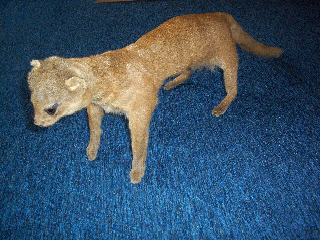What Is It?
Posted by: Loren Coleman on August 12th, 2010
Can you identify this taxidermy item?
Said not to be a weasel or known cat. But what is it?




The owner, a taxidermist for the last 30 years, writes: “It’s not a weasel. It’s never been Identified. This animal was mounted around the turn of the century. It was typical back then to mount the animals with the real skulls; this still has the skull and real teeth in it. It’s about the size of a cat.”

About Loren Coleman
Loren Coleman is one of the world’s leading cryptozoologists, some say “the” leading living cryptozoologist. Certainly, he is acknowledged as the current living American researcher and writer who has most popularized cryptozoology in the late 20th and early 21st centuries.
Starting his fieldwork and investigations in 1960, after traveling and trekking extensively in pursuit of cryptozoological mysteries, Coleman began writing to share his experiences in 1969. An honorary member of Ivan T. Sanderson’s Society for the Investigation of the Unexplained in the 1970s, Coleman has been bestowed with similar honorary memberships of the North Idaho College Cryptozoology Club in 1983, and in subsequent years, that of the British Columbia Scientific Cryptozoology Club, CryptoSafari International, and other international organizations. He was also a Life Member and Benefactor of the International Society of Cryptozoology (now-defunct).
Loren Coleman’s daily blog, as a member of the Cryptomundo Team, served as an ongoing avenue of communication for the ever-growing body of cryptozoo news from 2005 through 2013. He returned as an infrequent contributor beginning Halloween week of 2015.
Coleman is the founder in 2003, and current director of the International Cryptozoology Museum in Portland, Maine.










Meerkat. Next mystery? 🙂
At first I thought “Meerkat”, but then, seeing an image of one, perhaps not, unless it’s been “stuffed” around with.
Meerkat?
I think is a fossa (Cryptoprocta ferox) or a kinkajou (Potos flavus).
Mongoose.
It looks like a kinkajou.
The coloration looks wrong for meerkat or mongoose. But it’s right for kinkajou.
I would also say its a Honey Bear (Potos flavus), the size would well fit, as well as the colouration and fur. The shape of the head would also fit those of a Honey Bear.
I agree that it looks like a fossa – especially the body proprtions and muzzle shape. The color seems a bit light – could the hair have faded over the years? Compare to the image below.
Source
I thought Meerkat at first but after seeing the second picture the snout just looks all wrong to me. The toes and tail also look like they don’t fit the kinkajou very well either. The elongated body and fangs make me think some kind of weasel or stoat but those long legs throw me off again lol.
Fossas are in general much bigger, and I suppose the chance that any private person would get a fossa is rather small. The chance that somebody gets a stuffed honey bear is much bigger, some people have them even as pets. Furthermore the colouration doesn´t fit those of a fossa. Note also the absence of long whiskers in the stuffed animal. Fossas have them, honey bears don’t. Kinkajous have also a very short face, whereas those of fossas is nearly catlike. This is only a drawing, but it fits the posture of the stuffed animal better than those of any living Kinkajou, so it’s better for comparison.
The visible dentition also perfectly fits those of a Kinkajou.
It’s a very poor taxidermy job on a Jaguarundi.
I’m over 90 percent sure of it.
It’s an Eastern White Banded Rungdihal. They are native to Tiberia and are very rare except during the Summer Solstice. Their call is similar to a horned leopard chint toad. Very exciting!
Looks like a Meerkat at first blush, but after comparison not so much. The rear feet are weird in their positioning.
That is without a doubt, a very bad taxidermy job on a Kinkajou.
Let’s go with “good” taxidermy. The head of a meerkat or a close relative and the body of a skinny cat?
“It’s an Eastern White Banded Rungdihal. They are native to Tiberia and are very rare except during the Summer Solstice. Their call is similar to a horned leopard chint toad. Very exciting!”
We have an expression in Australia: You been yankin’ my chain?
I did initially consider a kinkajou as a suspect, but it’s not.
The tail isn’t nearly long enough. I’m still certain it’s a light phase Jaguarundi, albeit a poor tax job.
The Fossa is a good guess too, but the head shape on the specimen slopes at too steep of an angle and the face and muzzle are too rounded. It’s also not quite the right coloration for a fossa.
I’m still going with Jaguarundi, 99 percent.
It could be a kinkajou or kinkajou relative like an olingo, or possibly a fossa, but I seriously doubt it.
There’s no way it’s a meerkat or any known mustelid.
The identification would be much more easy if we would have better photos. A good photo of the dentition would make it sure if we have some kind of felid like a jaguarundi or a procyonid. Kinkajous are nearly completely frugivore, and jaguarundis strictly carnivore.
Jaguarundi. No doubt in my mind. Possibly a young one that was not well nourished.